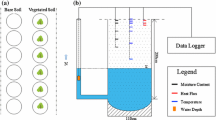Abstract
Net radiation, soil heat flux, incoming and reflected solar radiation, and soil water content were measured during several clear day periods following approximate 10-cm applications of water to loam soils at Phoenix, Arizona, and at Sidney, Montana. The regression of soil heat flux on net radiation changed significantly as the soil dried, with the difference between them being a linear function of the volumetric soil water content of the uppermost 2 to 4 cm of soil. The net radiation-soil heat flux difference for soil in an air-dry state was only about one-half of what it was on the day after irrigation. Techniques discussed allow evaluation of what the net radiation-soil heat flux difference would be under conditions of no surface saturation deficit at any time of year from measurements of net solar radiation, soil water content, and air temperature, thereby improving the utility of many evaporation models. The data also indicate that water content measurements may be replaced by more easily measured soil albedo.
Similar content being viewed by others
References
Burman, R. D., Wright, J. L., and Jensen, M. E.: 1975, Changes in Climate and Potential Evapotranspiration Across a Large Irrigated Area in Idaho, Trans. ASAE, submitted.
Fritschen, L. J.: 1963, ‘Construction and Evaluation of a Miniature Net Radiometer’, J. Appl. Meteorol. 2, 165–172.
Fritschen, L. J.: 1965, ‘Miniature Net Radiometer Improvements’, J. Appl. Meteorol. 4, 528–532.
Fuchs, M. and Hadas, A.: 1972, ‘The Heat Flux Density in a Non-Homogeneous Bare Loessial Soil. Boundary-Layer Meteorol. 3, 191–200.
Fuchs, M., Tanner, C. B., Thurtell, G. W., and Black, T. A.: 1969, ‘Evaporation from Drying Surfaces by the Combination Method’, Agron. J. 61, 22–26.
Idso, S. B.: 1972, ‘Calibration of Soil Heat Flux Plates by a Radiation Technique’, Agr. Meteorol. 10, 467–471.
Idso, S. B. and Cooley, K. R.: 1971, ‘The Vertical Location of Net Radiometers I. The Effects of the Underlying Air Layer’, J. Meteorol. Soc. Japan 49, 343–349.
Idso, S. B. and Cooley, K. R.: 1972, ‘The Vertical Location of Net Radiomaters II. The Effects of the Net Radiometer's Shadow’, J. Meteorol. Soc. Japan 50, 49–58.
Idso, S. B. and Jackson, R. D.: 1969, ‘Thermal Radiation from the Atmosphere’, J. Geophys. Res. 74, 5397–5403.
Idso, S. B., Reginato, R. J., Jackson, R. D., Kimball, B. A., and Nakayama, F. S.: 1974, ‘The Three Stages of Drying of a Field Soil’, Soil Sci. Soc. Amer. Proc. 38, 831–738.
Idso, S. B., Jackson, R. D., Reginato, R. J., Kimball, B. A., and Nakayama, F. S.: 1975a, ‘The Dependence of Bare Soil Albedo on Soil Water Content’, J. Appl. Meteorol. 14, 109–113.
Idso, S. B., Reginato, R. J., and Jackson, R. D.: 1975b, Assessing Bare Soil Evaporation via Surface Temperature Measurements, Hydrol. and Water Res. in Ariz. and the Southwest 5, in press.
Jackson, R. D.: 1973, ‘Diurnal Changes in Soil Water Content During Drying’, in Field Soil Water Regime, Spec. Publ. No. 5 Soil Sci. Soc. Amer. Proc., 37–55.
Jackson. R. D., Kimball, B. A., Reginato, R. J., and Nakayama, F. S.: 1973, ‘Diurnal Soil-Water Evaporation: Time-Depth-Flux Patterns’, Soil Sci. Soc. Amer. Proc. 34, 505–509.
Monteith, J. L.: 1963, ‘Gas Exchange in Plant Communities’, in L. T. Evans (ed.), Environmental Control of Plant Growth, Academic Press, New York, 95–112.
Monteith, J. L.: 1965, ‘Evaporation and Environment’, in G. E. Fogg (ed.), The State and Movement of Water in Living Organisms, Academic Press, New York, 205–234.
Penman, H. L.: 1948, ‘Natural Evaporation from Open Water, Bare Soil, and Grass’, Proc. Roy. Soc. London A 193, 120–145.
Penman, H. L.: 1961, ‘Weather, Plant and Soil Factors in Hydrology’, Weather 16, 207–219.
Penman, H. L. and Schofield, R. K.: 1951, ‘Some Physical Aspects of Assimilation and Transpiration’, Symp. Soc. Exp. Biol. 5, 115–129.
Priestley, C. H. B. and Taylor, R. J.: 1972, ‘On the Assessment of Surface Heat Flux and Evaporation Using Large-Scale Parameters’, Monthly Weather Rev. 100, 81–92.
Slatyer, R. O. and McIlroy, I. C.: 1961, Practical Microclimatology, CSIRO, Plant Ind. Div., Canberra, Aust., 328 pp.
Tanner, C. B. and Fuchs, M.: 1968, ‘Evaporation from Unsaturated Surfaces: A Generalized Combination Method’, J. Geophys. Res. 73, 1299–1304.
Van Bavel, C. H. M.: 1966, ‘Potential Evaporation: The Combination Concept and its Experimental Verification’, Wat Resources Res. 2, 455–467.
Author information
Authors and Affiliations
Additional information
Contribution from the Agricultural Research Service, U.S. Department of Agriculture.
Rights and permissions
About this article
Cite this article
Idso, S.B., Aase, J.K. & Jackson, R.D. Net radiation — soil heat flux relations as influenced by soil water content variations. Boundary-Layer Meteorol 9, 113–122 (1975). https://doi.org/10.1007/BF00232257
Revised:
Issue Date:
DOI: https://doi.org/10.1007/BF00232257




